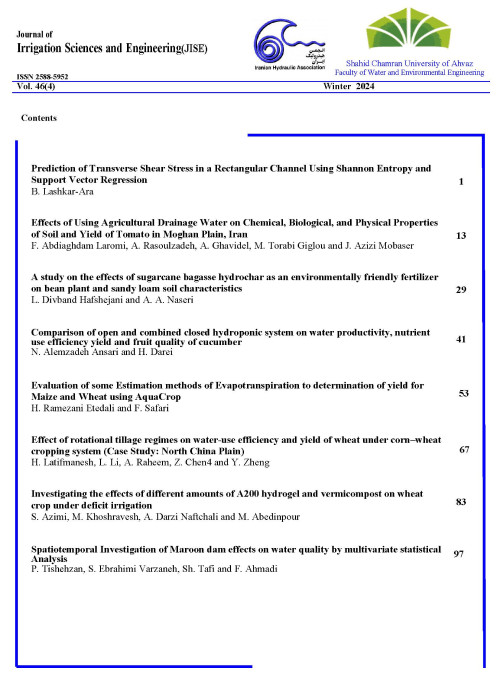Effects of Nose and Piano Keys Weir Parapet Wall on Floating Woody Debris
Author(s):
Article Type:
Research/Original Article (دارای رتبه معتبر)
Abstract:
A hydraulic structure is a device designed to retain, regulate, or control the flow of water. The most common type of hydraulic structures are weirs. Weirs are overflow structures that stretch across an open channel of water, and are meant to alter the channels flow characteristics making it easier to measure the volumetric rate of water flow. The Piano Key Weir (PKW), a type of Labyrinth weir is a hydraulically attractive option to linear overflow weirs, increasing the unit discharge for similar heads and spillway widths (Anderson, 2011). Together with its high discharge capacity for low heads, this geometry makes these weirs interesting in dam (Laugier, 2007). Discharge passing capacity of piano key weir is higher than that of labyrinth weir for same condition (Anderson and Tullis, 2013). In PKW type A, the upstream and downstream overhangs are existence, and if PK weir without downstream, upstream or both overhangs, it is B, C and D respectively (Lemperier and Quamane, 2003).
Anytime an engineered structure like a weir structure is placed in a river environment, the possibility exists that it will encounter debris. The impact of this debris on a structure is an important aspect of the design (Pagliara and Carnacina, 2010). Historically, debris accumulation on bridge piers and hydroelectric dams has been among the chief concerns associated with river debris. As the amount of debris builds on an object, the force it exerts on the object can result in catastrophic failure and it reduces the flow, resulting in the buildup of a backwater and greatly reducing the efficiency of energy conversion.
Due to the geometric properties and low flow head of PK weir, floating debris obstruction can occur in this structure. As shown in Fig.1, fundamental parameters on a PKW are including: height of PK-Weir P, total width of PK-Weir W, inlet key width Wi, outlet key width Wo, length of PKW B, PK weir footprint length Bb, upstream (outlet key) overhang lengths Bo, downstream (inlet key) overhang lengths Bi, weir wall thickness Ts, and flow discharge Q. In this research the effect of floating debris on PK weir obstruction investigated experimentally. The geometry of PKW and debris parameter was studied.
Anytime an engineered structure like a weir structure is placed in a river environment, the possibility exists that it will encounter debris. The impact of this debris on a structure is an important aspect of the design (Pagliara and Carnacina, 2010). Historically, debris accumulation on bridge piers and hydroelectric dams has been among the chief concerns associated with river debris. As the amount of debris builds on an object, the force it exerts on the object can result in catastrophic failure and it reduces the flow, resulting in the buildup of a backwater and greatly reducing the efficiency of energy conversion.
Due to the geometric properties and low flow head of PK weir, floating debris obstruction can occur in this structure. As shown in Fig.1, fundamental parameters on a PKW are including: height of PK-Weir P, total width of PK-Weir W, inlet key width Wi, outlet key width Wo, length of PKW B, PK weir footprint length Bb, upstream (outlet key) overhang lengths Bo, downstream (inlet key) overhang lengths Bi, weir wall thickness Ts, and flow discharge Q. In this research the effect of floating debris on PK weir obstruction investigated experimentally. The geometry of PKW and debris parameter was studied.
Keywords:
Language:
Persian
Published:
Irrigation Sciences and Engineering, Volume:40 Issue: 3, 2017
Pages:
99 to 107
https://magiran.com/p1775241
دانلود و مطالعه متن این مقاله با یکی از روشهای زیر امکان پذیر است:
اشتراک شخصی
با عضویت و پرداخت آنلاین حق اشتراک یکساله به مبلغ 1,390,000ريال میتوانید 70 عنوان مطلب دانلود کنید!
اشتراک سازمانی
به کتابخانه دانشگاه یا محل کار خود پیشنهاد کنید تا اشتراک سازمانی این پایگاه را برای دسترسی نامحدود همه کاربران به متن مطالب تهیه نمایند!
توجه!
- حق عضویت دریافتی صرف حمایت از نشریات عضو و نگهداری، تکمیل و توسعه مگیران میشود.
- پرداخت حق اشتراک و دانلود مقالات اجازه بازنشر آن در سایر رسانههای چاپی و دیجیتال را به کاربر نمیدهد.
In order to view content subscription is required
Personal subscription
Subscribe magiran.com for 70 € euros via PayPal and download 70 articles during a year.
Organization subscription
Please contact us to subscribe your university or library for unlimited access!



